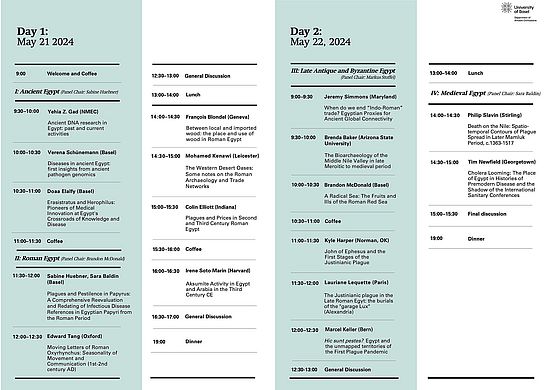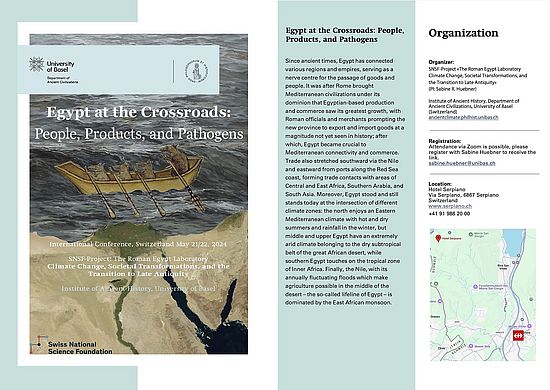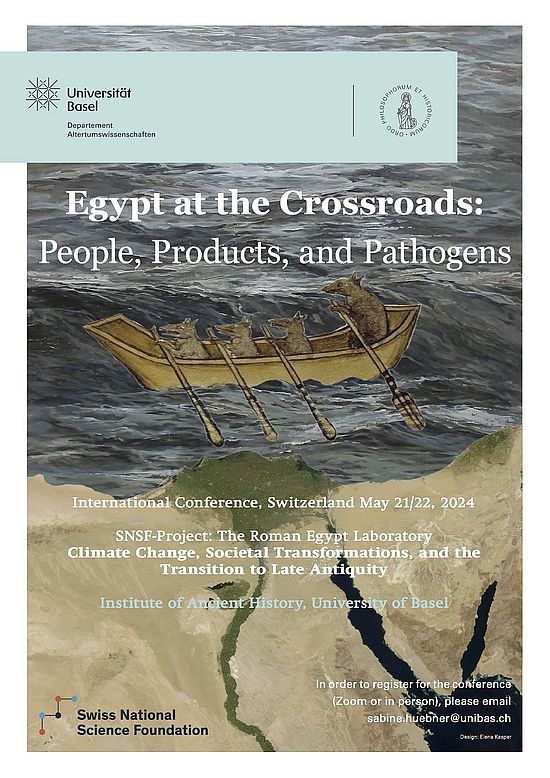
May 21/22, 2024 | SwitzerlandInternational Conference “Egypt at the Crossroads: People, Products, and Pathogens"
Egypt at the Crossroads: People, Products, and Pathogens
Organized by the “The Roman Egypt Laboratory: Climate, Change, Societal Transformations, and the Transition to Late Antiquity”, University of Basel, Switzerland
Since ancient times, Egypt has connected various regions and empires, serving as a nerve centre for the passage of goods and people. It was after Rome brought Mediterranean civilizations under its dominion that Egyptian-based production and commerce saw its greatest growth, with Roman officials and merchants prompting the new province to export and import goods at a magnitude not yet seen in history; after which, Egypt became crucial to Mediterranean connectivity and commerce. Trade also stretched southward via the Nile and eastward from ports along the Red Sea coast, forming trade contacts with areas of Central and East Africa, Southern Arabia, and South Asia. Moreover, Egypt stood and still stands today at the intersection of different climate zones: the north enjoys an Eastern Mediterranean climate with hot and dry summers and rainfall in the winter, but middle and upper Egypt have an extremely arid climate belonging to the dry subtropical belt of the great African desert, while southern Egypt touches on the tropical zone of Inner Africa. Finally, the Nile, with its annually fluctuating floods which make agriculture possible in the middle of the desert – the so-called lifeline of Egypt – is dominated by the East African monsoon.
This location, at the crossroads of South Asia, Arabia, central Africa and the Mediterranean, in effect linking various ecological zones, not only allowed people and products to flow, but also pathogens. Written, archaeological and documentary evidence illustrate a more productive and connected Egypt in its first two centuries under Roman rule, followed by a critical hundred or so years fraught with economic regression, geo- and socio-political turmoil, and frequent outbreaks of disease. The Nile valley had a reputation in the Greco-Roman world as a source of infectious disease for the Mediterranean region, potentially spreading either north along the Nile River from the regions of inner Africa south of Egypt, or across the western Indian Ocean from East Africa, Southern Arabia or South Asia to Egyptian Red Sea ports. But the extent to which Egypt received pathogens from abroad and passed them on to the Mediterranean is understudied.
This conference – organized within the frame of the SNSF-Project “The Roman Egypt Laboratory: Climate, Change, Societal Transformations, and the Transition to Late Antiquity” (PI: Sabine R. Huebner) – will investigate aspects that stimulated Roman Egypt’s progression to regional nexus and economic giant, the ways in which that evolution contributed to its Middle Imperial deterioration and eventual annexation in the later third century CE, and how this all reshaped the region for late antiquity. We are inviting historians, archaeologists, papyrologists, epidemiologists, and palaeoclimatologists to discuss topics that evaluate how a well-connected Egypt affected (for better or worse) societies within the region itself, as well as those linked to it in the Mediterranean, East Africa, Arabia, and South Asia.
The event is organized within the framework of the Basel research project ‘The Roman Egypt Laboratory: Climate Change, Societal Transformations, and the Transition to Late Antiquity’ and funded by the Swiss National Science Foundation (SNSF). Confirmed speakers include Brenda Baker (Arizona), Sara Baldin (Basel), Francois Blondel (Geneva), Christophe Corona (CNRS), Doaa Elalfy (Basel), Colin Elliot (Indiana), Yehia Gad (Cairo), Kyle Harper (Oklahoma), Marcel Keller (Bern), Mohamed Kenawi (Leicester), Laurianne Lequette (Paris), Irene Soto Marín (Harvard), Brandon McDonald (Basel), Timothy Newfield (Georgetown), Verena Schünemann (Basel), Jeremy Simmons (Maryland), Philip Slavin (Stirling), Markus Stoffel (Geneva) and Edward Tang (Oxford).



